Qin Lu
Fine-tuning LLMs with variational Bayesian last layer for high-dimensional Bayesian optimzation
Oct 01, 2025Abstract:A plethora of applications entail solving black-box optimization problems with high evaluation costs, including drug discovery, material design, as well as hyperparameter tuning. Toward finding the global optimum of such black-box optimization problems with sample efficiency, Bayesian optimization (BO) is a theoretically elegant framework that relies on a probabilistic surrogate model so as to iteratively select the query point with well-balanced exploration-exploitation tradeoffs. The Gaussian process (GP), as the de-facto choice for surrogate modeling, has achieved compelling performances for vanilla BO with low-dimensional continuous variables. However, GPs fall short in coping with high-dimensional counterparts with {\it irregular} variables (e.g., categorical, ordinal, etc.). To alleviate this, neural network-based surrogates have been explored. Inspired by the powerful capabilities of LLMs, we adopt the LLM as the surrogate to model the mapping from the high-dimensional input variables to the objective function. To adapt to the current problem, we leverage the low-rank adaptation (LoRA) to fine-tune the LLM parameters together with the posterior of a linear regression head via the variational Bayesian last layer (VBLL) framework. The resulting LoRA-VBLL is not only computationally light compared to existing alternatives, but also admits recursive updates. To automate the critical selection of the LoRA rank as well as other hyperparameters, a weighted ensemble (ENS) of LoRA-VBLL surrogates has been devised, which further accommodates continual update of the per-model weight and individual LoRA-VBLL parameters via recursive Bayes. Extensive experimental results demonstrate the compelling performance of the proposed (ENS-)LoRA-VBLL approaches on various high-dimensional benchmarks and the real-world molecular optimization tasks.
Deploying AI for Signal Processing education: Selected challenges and intriguing opportunities
Sep 10, 2025Abstract:Powerful artificial intelligence (AI) tools that have emerged in recent years -- including large language models, automated coding assistants, and advanced image and speech generation technologies -- are the result of monumental human achievements. These breakthroughs reflect mastery across multiple technical disciplines and the resolution of significant technological challenges. However, some of the most profound challenges may still lie ahead. These challenges are not purely technical but pertain to the fair and responsible use of AI in ways that genuinely improve the global human condition. This article explores one promising application aligned with that vision: the use of AI tools to facilitate and enhance education, with a specific focus on signal processing (SP). It presents two interrelated perspectives: identifying and addressing technical limitations, and applying AI tools in practice to improve educational experiences. Primers are provided on several core technical issues that arise when using AI in educational settings, including how to ensure fairness and inclusivity, handle hallucinated outputs, and achieve efficient use of resources. These and other considerations -- such as transparency, explainability, and trustworthiness -- are illustrated through the development of an immersive, structured, and reliable "smart textbook." The article serves as a resource for researchers and educators seeking to advance AI's role in engineering education.
Think-RM: Enabling Long-Horizon Reasoning in Generative Reward Models
May 22, 2025Abstract:Reinforcement learning from human feedback (RLHF) has become a powerful post-training paradigm for aligning large language models with human preferences. A core challenge in RLHF is constructing accurate reward signals, where the conventional Bradley-Terry reward models (BT RMs) often suffer from sensitivity to data size and coverage, as well as vulnerability to reward hacking. Generative reward models (GenRMs) offer a more robust alternative by generating chain-of-thought (CoT) rationales followed by a final reward. However, existing GenRMs rely on shallow, vertically scaled reasoning, limiting their capacity to handle nuanced or complex (e.g., reasoning-intensive) tasks. Moreover, their pairwise preference outputs are incompatible with standard RLHF algorithms that require pointwise reward signals. In this work, we introduce Think-RM, a training framework that enables long-horizon reasoning in GenRMs by modeling an internal thinking process. Rather than producing structured, externally provided rationales, Think-RM generates flexible, self-guided reasoning traces that support advanced capabilities such as self-reflection, hypothetical reasoning, and divergent reasoning. To elicit these reasoning abilities, we first warm-up the models by supervised fine-tuning (SFT) over long CoT data. We then further improve the model's long-horizon abilities by rule-based reinforcement learning (RL). In addition, we propose a novel pairwise RLHF pipeline that directly optimizes policies using pairwise preference rewards, eliminating the need for pointwise reward conversion and enabling more effective use of Think-RM outputs. Experiments show that Think-RM achieves state-of-the-art results on RM-Bench, outperforming both BT RM and vertically scaled GenRM by 8%. When combined with our pairwise RLHF pipeline, it demonstrates superior end-policy performance compared to traditional approaches.
WebAgent-R1: Training Web Agents via End-to-End Multi-Turn Reinforcement Learning
May 22, 2025Abstract:While reinforcement learning (RL) has demonstrated remarkable success in enhancing large language models (LLMs), it has primarily focused on single-turn tasks such as solving math problems. Training effective web agents for multi-turn interactions remains challenging due to the complexity of long-horizon decision-making across dynamic web interfaces. In this work, we present WebAgent-R1, a simple yet effective end-to-end multi-turn RL framework for training web agents. It learns directly from online interactions with web environments by asynchronously generating diverse trajectories, entirely guided by binary rewards depending on task success. Experiments on the WebArena-Lite benchmark demonstrate the effectiveness of WebAgent-R1, boosting the task success rate of Qwen-2.5-3B from 6.1% to 33.9% and Llama-3.1-8B from 8.5% to 44.8%, significantly outperforming existing state-of-the-art methods and strong proprietary models such as OpenAI o3. In-depth analyses reveal the effectiveness of the thinking-based prompting strategy and test-time scaling through increased interactions for web tasks. We further investigate different RL initialization policies by introducing two variants, namely WebAgent-R1-Zero and WebAgent-R1-CoT, which highlight the importance of the warm-up training stage (i.e., behavior cloning) and provide insights on incorporating long chain-of-thought (CoT) reasoning in web agents.
Bayesian Optimization for Robust Identification of Ornstein-Uhlenbeck Model
Mar 09, 2025



Abstract:This paper deals with the identification of the stochastic Ornstein-Uhlenbeck (OU) process error model, which is characterized by an inverse time constant, and the unknown variances of the process and observation noises. Although the availability of the explicit expression of the log-likelihood function allows one to obtain the maximum likelihood estimator (MLE), this entails evaluating the nontrivial gradient and also often struggles with local optima. To address these limitations, we put forth a sample-efficient global optimization approach based on the Bayesian optimization (BO) framework, which relies on a Gaussian process (GP) surrogate model for the objective function that effectively balances exploration and exploitation to select the query points. Specifically, each evaluation of the objective is implemented efficiently through the Kalman filter (KF) recursion. Comprehensive experiments on various parameter settings and sampling intervals corroborate that BO-based estimator consistently outperforms MLE implemented by the steady-state KF approximation and the expectation-maximization algorithm (whose derivation is a side contribution) in terms of root mean-square error (RMSE) and statistical consistency, confirming the effectiveness and robustness of the BO for identification of the stochastic OU process. Notably, the RMSE values produced by the BO-based estimator are smaller than the classical Cram\'{e}r-Rao lower bound, especially for the inverse time constant, estimating which has been a long-standing challenge. This seemingly counterintuitive result can be explained by the data-driven prior for the learning parameters indirectly injected by BO through the GP prior over the objective function.
Online scalable Gaussian processes with conformal prediction for guaranteed coverage
Oct 07, 2024


Abstract:The Gaussian process (GP) is a Bayesian nonparametric paradigm that is widely adopted for uncertainty quantification (UQ) in a number of safety-critical applications, including robotics, healthcare, as well as surveillance. The consistency of the resulting uncertainty values however, hinges on the premise that the learning function conforms to the properties specified by the GP model, such as smoothness, periodicity and more, which may not be satisfied in practice, especially with data arriving on the fly. To combat against such model mis-specification, we propose to wed the GP with the prevailing conformal prediction (CP), a distribution-free post-processing framework that produces it prediction sets with a provably valid coverage under the sole assumption of data exchangeability. However, this assumption is usually violated in the online setting, where a prediction set is sought before revealing the true label. To ensure long-term coverage guarantee, we will adaptively set the key threshold parameter based on the feedback whether the true label falls inside the prediction set. Numerical results demonstrate the merits of the online GP-CP approach relative to existing alternatives in the long-term coverage performance.
Syllable based DNN-HMM Cantonese Speech to Text System
Feb 13, 2024Abstract:This paper reports our work on building up a Cantonese Speech-to-Text (STT) system with a syllable based acoustic model. This is a part of an effort in building a STT system to aid dyslexic students who have cognitive deficiency in writing skills but have no problem expressing their ideas through speech. For Cantonese speech recognition, the basic unit of acoustic models can either be the conventional Initial-Final (IF) syllables, or the Onset-Nucleus-Coda (ONC) syllables where finals are further split into nucleus and coda to reflect the intra-syllable variations in Cantonese. By using the Kaldi toolkit, our system is trained using the stochastic gradient descent optimization model with the aid of GPUs for the hybrid Deep Neural Network and Hidden Markov Model (DNN-HMM) with and without I-vector based speaker adaptive training technique. The input features of the same Gaussian Mixture Model with speaker adaptive training (GMM-SAT) to DNN are used in all cases. Experiments show that the ONC-based syllable acoustic modeling with I-vector based DNN-HMM achieves the best performance with the word error rate (WER) of 9.66% and the real time factor (RTF) of 1.38812.
Spatial-Assistant Encoder-Decoder Network for Real Time Semantic Segmentation
Sep 19, 2023



Abstract:Semantic segmentation is an essential technology for self-driving cars to comprehend their surroundings. Currently, real-time semantic segmentation networks commonly employ either encoder-decoder architecture or two-pathway architecture. Generally speaking, encoder-decoder models tend to be quicker,whereas two-pathway models exhibit higher accuracy. To leverage both strengths, we present the Spatial-Assistant Encoder-Decoder Network (SANet) to fuse the two architectures. In the overall architecture, we uphold the encoder-decoder design while maintaining the feature maps in the middle section of the encoder and utilizing atrous convolution branches for same-resolution feature extraction. Toward the end of the encoder, we integrate the asymmetric pooling pyramid pooling module (APPPM) to optimize the semantic extraction of the feature maps. This module incorporates asymmetric pooling layers that extract features at multiple resolutions. In the decoder, we present a hybrid attention module, SAD, that integrates horizontal and vertical attention to facilitate the combination of various branches. To ascertain the effectiveness of our approach, our SANet model achieved competitive results on the real-time CamVid and cityscape datasets. By employing a single 2080Ti GPU, SANet achieved a 78.4 % mIOU at 65.1 FPS on the Cityscape test dataset and 78.8 % mIOU at 147 FPS on the CamVid test dataset. The training code and model for SANet are available at https://github.com/CuZaoo/SANet-main
Towards Artificial General Intelligence (AGI) in the Internet of Things (IoT): Opportunities and Challenges
Sep 14, 2023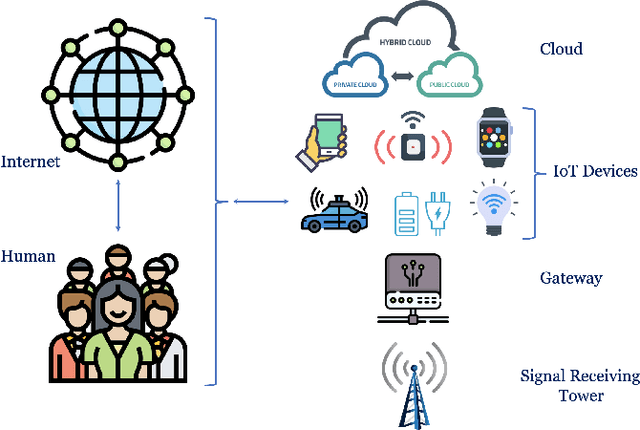
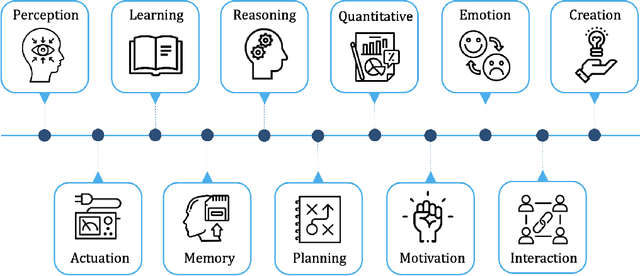
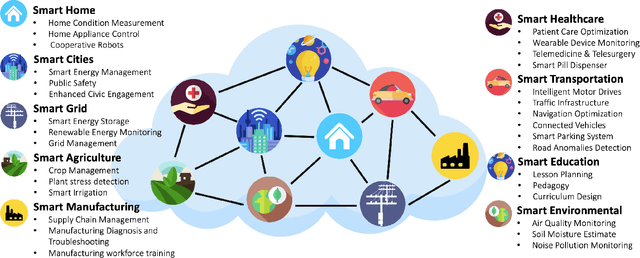
Abstract:Artificial General Intelligence (AGI), possessing the capacity to comprehend, learn, and execute tasks with human cognitive abilities, engenders significant anticipation and intrigue across scientific, commercial, and societal arenas. This fascination extends particularly to the Internet of Things (IoT), a landscape characterized by the interconnection of countless devices, sensors, and systems, collectively gathering and sharing data to enable intelligent decision-making and automation. This research embarks on an exploration of the opportunities and challenges towards achieving AGI in the context of the IoT. Specifically, it starts by outlining the fundamental principles of IoT and the critical role of Artificial Intelligence (AI) in IoT systems. Subsequently, it delves into AGI fundamentals, culminating in the formulation of a conceptual framework for AGI's seamless integration within IoT. The application spectrum for AGI-infused IoT is broad, encompassing domains ranging from smart grids, residential environments, manufacturing, and transportation to environmental monitoring, agriculture, healthcare, and education. However, adapting AGI to resource-constrained IoT settings necessitates dedicated research efforts. Furthermore, the paper addresses constraints imposed by limited computing resources, intricacies associated with large-scale IoT communication, as well as the critical concerns pertaining to security and privacy.
Recipes for Sequential Pre-training of Multilingual Encoder and Seq2Seq Models
Jun 14, 2023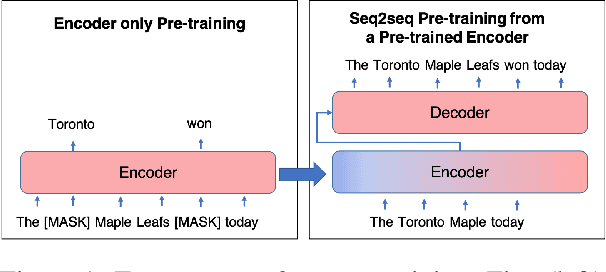
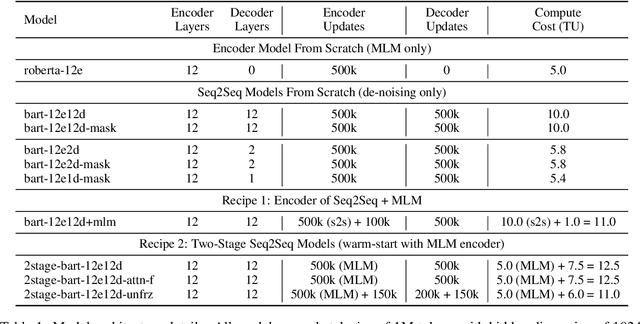
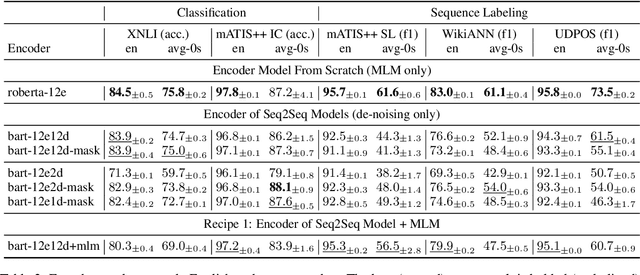

Abstract:Pre-trained encoder-only and sequence-to-sequence (seq2seq) models each have advantages, however training both model types from scratch is computationally expensive. We explore recipes to improve pre-training efficiency by initializing one model from the other. (1) Extracting the encoder from a seq2seq model, we show it under-performs a Masked Language Modeling (MLM) encoder, particularly on sequence labeling tasks. Variations of masking during seq2seq training, reducing the decoder size, and continuing with a small amount of MLM training do not close the gap. (2) Conversely, using an encoder to warm-start seq2seq training, we show that by unfreezing the encoder partway through training, we can match task performance of a from-scratch seq2seq model. Overall, this two-stage approach is an efficient recipe to obtain both a multilingual encoder and a seq2seq model, matching the performance of training each model from scratch while reducing the total compute cost by 27%.
 Add to Chrome
Add to Chrome Add to Firefox
Add to Firefox Add to Edge
Add to Edge